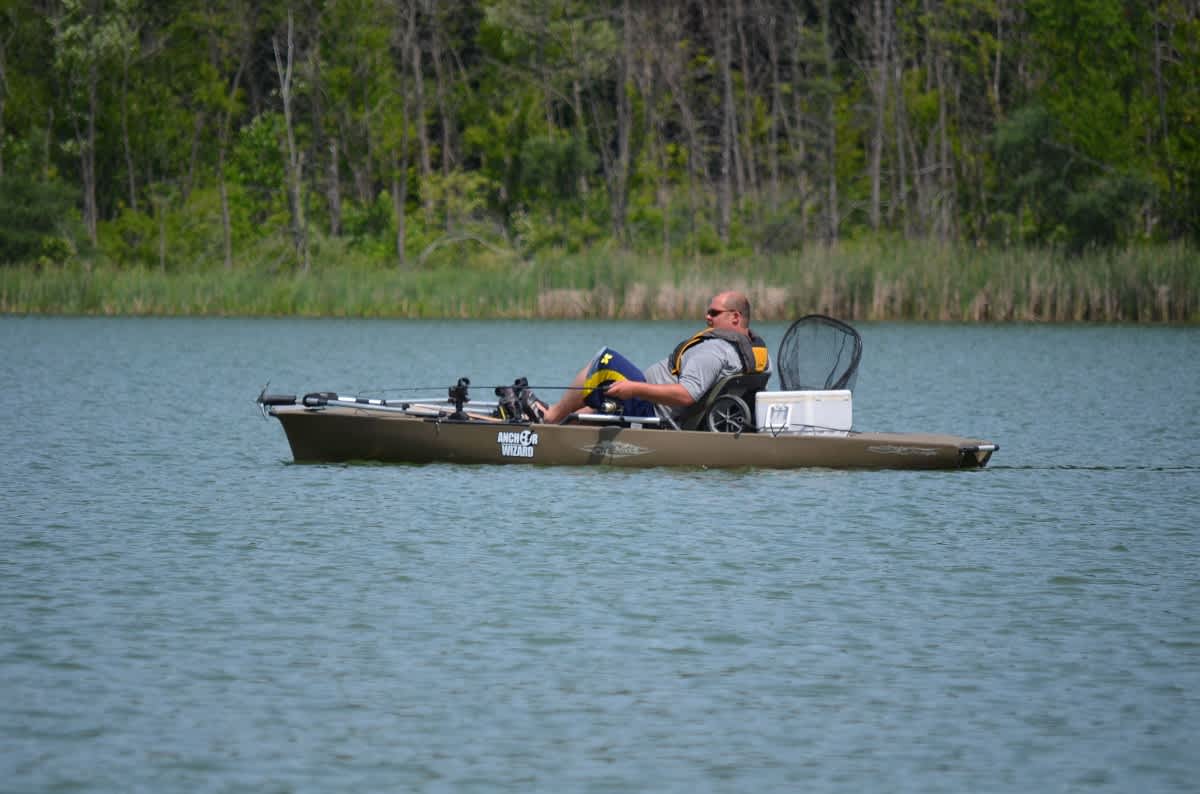In-depth Trolling for Michigan Panfish
Dave Mull 06.18.14

“Trolling for bluegills? I’ve never heard of such a thing,” the guy in the canoe said across the water after I told him what I was doing.
He was busy tossing bass lures along the shoreline of the little lake while I was out over the 30-foot depths of the basin, pedaling my Hobie kayak, two ultra-light rods in the water. At the business end of each was a pair of small Worden’s Spin-Glos, each with a No. 6 Tru-Turn long-shank hook. One was baited with two waxworms; the other had a one-inch Gulp! Pinched Crawler, made by Berkley.
Normally this body of water, accessible only to kayaks, canoes, and other small boats that can paddle a long ways up a small stream, is the site of panfish pandemonium. Last Sunday, it wasn’t nearly up to its usual snuff, but I’d still been able to put five decent bluegills and a nice crappie in my cooler by mid-morning. The ’gills had just recently left the beds, and just weren’t biting with their usual zeal. But I left a couple hours later after adding two more crappies and two more bluegills, a total of 10 panfish worthy of a fillet knife.
Trolling for bluegills and crappies is not really new—my grandfather introduced me to the technique decades ago on Southern Michigan’s Corey Lake, slowly rowing his old iron boat with long rods set with 3/4-ounce bell sinkers and two baits (usually a cricket and a catalpa worm) on dropper lines above. Rowing allowed him to cover water and find fish without the luxury of a fish-finding sonar unit.

With today’s trolling motors and pedal-powered kayaks, it’s a lot easier target fish by trolling, and modern anglers have a wide choice of different lures and set ups to deploy. While the double Spin-N-Glo rig and Wedding Ring Spinners from Mack’s Lures have become personal favorites, small crankbaits as well as downsized spinner blades can also be hugely effective. As with any kind of trolling, a good bait is just the start. You also have to consider depth and speed.
Depth with spinners and bait depends on the amount of weight you add to the line, how much line you let out and the speed of your boat. Crankbait depth largely depends on how deep the specific lure can dive and how far back you set it. Tiny lures with small lips often need added weight to get to productive depths.
Lacking line-counter trolling reels and using light spinning tackle makes depth control a “best guess” proposition. What matters is keeping track of about how much line you let out and being able to repeat that amount after a fish bites and tells you that your bait was in the right zone.
“I like to use the ‘rod sweep’ method,” said Elmer Clarke of Battle Creek, a veteran panfish troller. Clarke, who spends about 40 days a year pulling his 16-foot Lund around a variety of Michigan lakes with an electric trolling motor explained:
I put the bait in the water and with the rod parallel to the surface point the rod tip almost directly astern. Then, with the bail open but my finger ready to stop the line, I sweep my seven-foot rod almost all the way to the bow. At the end of the forward sweep, I stop the line, slowly point the rod back astern, letting the lure drop back, and repeat the forward sweep. Ideally, each sweep lets out the same amount of line. With a rod on either side of the boat I set the baits back different distances. One might be three sweeps and the other one six, and if I don’t get bit, I reset with different amounts of sweeps. When one of the rods gets bites, I match the amount of line out on the other rod. I don’t know exactly how deep the baits are, but I can reset with the same number of sweeps and know I’ll get to about the same depth.
Clarke noted that slow speeds—about one mile per hour—usually work best for panfish, as does light line, five- or six-pound test. Slow speed and light line mean he doesn’t need a lot of weight to get the bait fairly deep—just a couple of medium-size split shot is his starting point. If the fish are deeper, he adds another shot or two. The shot, by the way, go on the main line ahead of a good ball-bearing snap swivel to keep the spinners from twisting the line. Spin-N-Glos and Wedding Rings are on their own three- or four-foot leaders.
He also said that suspended panfish can be quite shallow, looking for a meal right on the surface, so running lures up high often works.
Bluegills and crappies can be quite selective about color and size. Pinks, greens, oranges, and yellows (or a combination of two colors) all have their days. On the lake I fished Sunday, a green and pink combo out-fished all others, and the bigger fish spurned waxworms but hit a pink Gulp! Pinched Nightcrawler. Sometimes, with the Spin-N-Glo rigs, just a single Spin-N-Glo outfishes the double set up. Crappies often prefer a small crankbait and more often than not, a bluegills will hit a hardbody, too. It pays to experiment.
Many panfish enthusiasts have a hard time giving up anchoring and waiting for a bobber to go down. Once they figure out how effective trolling can be, they might start leaving the anchor at home.
For more information on Michigan fishing go to michigan.org. Click here to purchase a Michigan fishing license online.
This article was produced in partnership with Pure Michigan.

